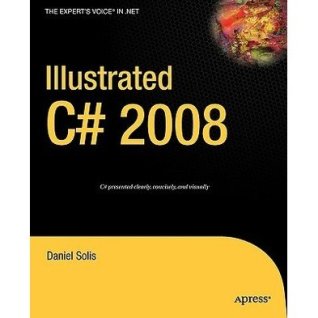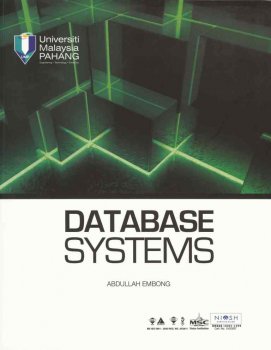
Illustrated C# 2008 …..
November 29, 2017
Got this book from National Library (PNM) on 11/11/2017….The book tell us about how to program in C# language , you’ll have a thorough working knowledge of all aspects of the C# language , whether you’re a novice programmer or a seasoned veteran of other languages. The chapter covers in this book is about types , storage and variables , classes , methods , classes and inheritance , expressions and operators , statements , namespaces and assemblies , exceptions , structs and many more…Illustrations alone , however , are not sufficient to explain a programming language and platform. The goal of this book is to find the best combination of words and illustrations to give you a thorough understanding of the language , and to allow the book to serve as a reference resource as well.
The compiler for a .NET language takes a source code file and produces an output file called an assembly. An assembly is either an executable or a DLL. The process is illustrated here….The code in an assembly is not native machine code , but an intermediate language called the Common Intermediate Language ( CIL ) . An assembly , among other things , contains the following items :
1. The program’s CIL
2. Metadata about types used in the program.
3. Metadata about references to other assemblies.
The acronym for the intermediate language has changed over time , and different references use different terms. Two other terms for the CIL that you might encounter are IL ( Intermediate Language ) and MSIL ( Microsoft Intermediate Language ) , which was used during initial development and early documentation.
Some types , such as short , int , and long , are called simple types , and can only store a single data item. Other types can store multiple data items. An array, for example , is a type that can store multiple items of the same type. The individual items are called elements , and are referenced by a number , called an index. Other types , however , can contain data items of many different types. The individual elements in these types are called members , and , unlike arrays , in which each member is referenced to by a number , these members have distinct names. There are two types of members: data members and function members.
1. Data members store data that is relevant to the object of the class or the class itself.
2. Function members execute code. Function members define how the type can act.
A method is a named block of executable code that can be executed from many different parts of the program , and even from other programs. ( There are also anonymous methods , which aren’t named ). When a method is called , or invoked , it executes its code, and then returns to the code that called it. Some methods return a value to the position from which they were called. Methods correspond to member functions in C++. The minimum syntax for declaring a method includes the following components :
1. Return type : This states the type of value the method returns. If a method does not return a value , the return type is specified as void.
2. Name : This is the name of the method.
3. Parameter list: This consist of at least an empty set of matching parentheses. If they are parameters , they are listed between the parentheses.
4. Method body : This consists of a matching set of curly braces , containing the executable code.
Some of these articles are taken from the excerpt from the book Illustrated C# 2008 written by Daniel Solis and published by APress.
Database Systems.
Received and read this book on 11/11/2017 and got it from National Library (PNM). The book discussed about database system and its usage in our daily activities . The important element in discussing database is to explain the data. Data and information are the basic elements contributing to the process of decision-making. As today’s society relies so much on information , data will be utilized and generated at all time. Before taking a step further , it is good to differentiate the terms data and information although occasionally both are used to refer to a similar item.
In the client-server architecture , database and DBMS are stored in a computer known as a server. Server computers usually possess higher processing capability which acts as the back end and connects to client computer. The client computer acts as the front end in a local area network as depicted. This design is able to reduce costs as we can use work stations or personal computers as a client and server. Besides sharing the database , client-server architecture allows sharing of other resources such as printers , scanners , data storage equipment and others. Request for the database usage will be made by the client while the server will provide database management and communication services. Client-server architecture are suitable for small and medium working groups such as library database system , student fee payment system , and a supermarket’s sales and inventory system.
Two main objectives in creating database are to achieve high level of data independence and high data abstraction. Specifically , data independence means changes in storage structure and data access techniques does not affect application program. This condition can be achieved because database does not only keep user data , but also data dictionary that includes information on structure of data in the database. It means information about data organisation and its access techniques need not be coded in application programs as being done in file processing system.
Data independence is important to database system because of two main factors:
1. The need of different users views for a set of same data. If data independence does not exist , we cannot provide different views from the same data.
2. Very dynamic database. Data and application program expand with the increase of user requirements. Just imagine if there is no data independence , programmers will spend so much time to write and change program codes when additional data requirements or change to storage structure occurs.
Data abstraction can be done as a result of data independence. Thus , users are not burdened with the database physical structure , but only need to focus on the abstract data views that they required. It also suitable to the different user views for different categories of users with the database shared by many. Data abstraction is supported by three-level architecture introduced by ANSI-SPARC in 1975 that has become fundamental to the architecture of several database systems today.
Internal level describes the data structure and the file organisations that enables data being physically stored in storage devices in the database. Internal level is interfaced with operating system access method in order to establish indexes , and data storage mechanisms. It shows that under internal level , there is an existence of physical level that is being controlled by operating system with DBMSs make full use of its operating system access method facilities , and other DBMSs use their own file organisation.
Internal schema written in DLL stated the metadata of internal level. It has information such as :
1. Data structure used
2. Data representation
3. Records sequence
4. Space and storage allocation for data and indexes.
Finally this book is a good book to read in the subject database systems. This book was written in the spirit of helping the students to learn the subject of database management system in a guided manner based on real life examples. Some of the articles are taken from the excerpt of the book Database System written by Prof Dr. Abdullah Embong printed in 2010 and published by University Malaysia Pahang.


Leave a comment